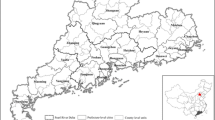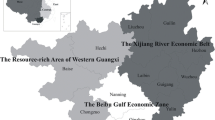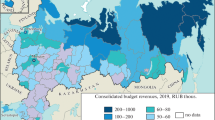Abstract
This paper advances the multi-mechanism framework, integrates the GIS technology and spatial panel data models for analyzing regional inequality mechanism. Applying this integrated methodology, we investigate China’s regional inequality at the county level using a comprehensive panel dataset that includes socioeconomic, environmental, locational, policy and GIS data from 1992 to 2010. The results show that Chinese regional inequality at the county level has a non-stationary dynamic structure, mirroring global inequality and spatial autocorrelation. In addition, the spatial panel data models analysis reveals the relative influence of explanatory variables. The impact of essential productive factors on regional development is gradually fading. Industrialization and decentralization play the most important role. The influence of marketization on regional development is not clear. The expansion of urban built-up areas has exerted a strong influence on the uneven regional development. Policy and transportation factor plays an indispensable role in regional inequality. The analysis additionally recognizes that socioeconomic factors play a dominant role, beyond policy and location factors. The role of environmental factors appears to be masked. This paper suggests that more attention needs to be paid to micro-inequality to coordinate inter-county and intra-county inequality under the pressure of rapid industrialization, urbanization and modernization of agriculture. Given the pattern of economic development, deepening balanced development reforms, optimizing and upgrading the industrial structure might be effective ways to develop a more coordinated regional development structure in China at the county level.




Similar content being viewed by others
Notes
The coefficient of variation is defined as \(CV_{\left( w\right) } =\sqrt{\sum \nolimits _{i=1}^{n} {\left( {x^i -\mu }\right) ^{2}~f\left( {x_{i}} \right) }}/\mu \) where \(x_{i}\) is the per capita GDP of county \(i,\,\mu \) is the mean of per capita GDP, and \(f(x_i)\) is the share of population of country \(i\) in the total samples.
The Gini coefficient is defined as \(G_{\left( w\right) } =\frac{1}{2\mu }\sum \nolimits _{j=1}^{{n}} {\sum \nolimits _{i=1}^{n} {f\left( {x_{i}}\right) f\left( {x_{j}}\right) |x_{i} -x_{j}|}}\) where \(f (x_{i})\) is the share of population of country \(i\) in the total samples, \(f (x_{j})\) is the share of per capita GDP of county \(j\) in the total samples, and \(\left| {x_{i} -x_{j}}\right| \) is absolute value of every county.
The Theil index is defined as \(T_{(w)} =\sum \nolimits _{i=1}^{n} {g(x_{i})} \ln \frac{f(x_{i})}{\mu }\) where \(g(x_i)\) is the share of per capita GDP of county \(i\) in the total samples.
References
Anselin L (2005) Exploring spatial data with GeoDa: a workbook. Center for spatially integrated social science
Anselin L (1988) Spatial economy: methods and models. Kluwer Academic Publisher, Dordrecht
Bao C, Fang CL (2007) Water resources constraint force on urbanization in water deficient regions: a case study of the Hexi Corridor, arid area of NW China. Ecol Econ 62(3–4):508–517
Beenstock M, Felsensteint D (2008) Regional heterogeneity, conditional convergence and regional inequality. Reg Stud 42(4):475–488
Bosker M (2009) The spatial evolution of regional GDP disparities in the ‘old’ and the ‘new’ Europe. Pap Reg Sci 88(1):3–27
Carlino G, Mills L (1996) Are US regional incomes converging? Reply. J Monet Econ 38(3):599–601
CCTB (Center Compilation and Translation Bureau) (2011) The twelfth five-year plan for national economic and social development of the People’s Republic of China. Central Compilation and Translation Press, Beijing
Cheshire PC, Malecki EJ (2004) Growth, development, and innovation: a look backward and forward. Pap Reg Sci 83(1):249–267
Cuaresma JC, Doppelhofer G, Feldkircher M (2012) The determinants of economic growth in European regions. Reg Stud. doi:10.1080/00343404.2012.678824
Das S, Sinha G, Mitra TK (2010) Regional convergence of growth, inequality and poverty in India—an empirical study. Econ Model 27(5):1054–1060
Demurger S, Sachs JD, Woo WT et al (2002a) Geography, economic policy, and regional development in China. in: NBER working paper series No.w8897, National Bureau of Economic Research, Cambridge, MA. Electronic resource
Demurger S, Sachs JD, Woo WT et al (2002b) The relative contributions of location and preferential policies in China’s regional development: being in the right place and having the right incentives. China Econ Rev 13(4):444–465
Deng XZ, Huang JK, Rozelle S et al (2008) Growth, population and industrialization, and urban land expansion of China. J Urban Econ 63(1):96–115
Dupont V (2007) Do geographical agglomeration, growth and equity conflict? Pap Reg Sci 86(2):193–213
Elhorst JP (2003) Specification and estimation of spatial panel data models. Int Reg Sci Rev 26(3):244–268
Elhorst JP (2010) Spatial panel data models. In: Fischer MM, Getis A (eds) Handbook of applied spatial analysis. Springer, Berlin
Elvidge CD, Baugh KE, Kihn EA et al (1997) Relation between satellite observed visible-near infrared emissions, population, economic activity and electric power consumption. Int J Remote Sens 18(6):1373–1379
Esposti R, Bussoletti S (2008) Impact of objective 1 funds on regional growth convergence in the European Union: a panel-data approach. Reg Stud 42(2):159–173
Fan CC (1997) Uneven development and beyond: regional development theory in post-Mao China. Int J Urban Reg 21(4):620–639
Fan CC, Sun MJ (2008) Regional inequality in China, 1978–2006. Eurasian Geogr Econ 49(1):1–20
Fleisher BM, Chen J (1997) The coast-noncoast income gap, productivity, and regional economic policy in China. J Comp Econ 25(2):220–236
Fleisher B, Li HZ, Zhao MQ (2010) Human capital, economic growth, and regional inequality in China. J Dev Econ 92(2):215–231
Fujita M, Hu DP (2001) Regional disparity in China 1985–1994: the effects of globalization and economic liberalization. Ann Reg Sci 35(1):3–37
Gardiner B, Martin R, Tyler P (2011) Does spatial agglomeration increase national growth? some evidence from Europe. J Econ Geogr 11(6):979–1006
Hao R, Wei Z (2009) Sources of income differences across Chinese provinces during the reform period: a development accounting exercise. Dev Econ 47(1):1–29
Ho CY, Li D (2008) Rising regional inequality in China: policy regimes and structural changes. Pap Reg Sci 87(2):245–259
Jones DC, Li C, Owen AL (2003) Growth and regional inequality in China during the reform era. China Econ Rev 14(2):186–200
Kanbur R, Zhang XB (1999) Which regional inequality? The evolution of rural–urban and inland–coastal inequality in China from 1983 to 1995. J Comp Econ 27(4):686–701
Kanbur R, Zhang XB (2005) Fifty years of regional inequality in China: a journey through central planning, reform, and openness. Rev Dev Econ 9(1):87–106
Lau CKM (2010) New evidence about regional income divergence in China. China Econ Rev 21(2):293–309
Li YR, Wei YHD (2010) The spatial-temporal hierarchy of regional inequality of China. Appl Geogr 30(3):303–316
Liao FHF, Wei YHD (2012) Dynamics, space, and regional inequality in provincial China: a case study of Guangdong province. Appl Geogr 35(1–2):71–83
Lin GCS (1999) State policy and spatial restructuring in post-reform China, 1978–95. Int J Urban Reg 23(4):670–696
Liu X, Yin X (2010) Spatial externalities and regional income inequality: evidence from China’s prefecture-level data. Front Econ China 5(2):325–338
Lu LC, Wei YHD (2007) Domesticating globalisation, new economic spaces and regional polarisation in Guangdong province, China. Tijdschr Econ Soc Geogr 98(2):225–244
Mason CH, Perreault WD (1991) Collinearity, power, and interpretation of multiple regression analysis. J Mark Res 28(3):268–280
Mora T (2008) Factors conditioning the formation of European regional convergence clubs. Ann Reg Sci 42(4):911–927
NBSC (National Bureau of Statistics of China) (2012) China statistical yearbook, 2012. Chinese Statistics Press, Beijing
Petrakos G, Saratsis Y (2000) Regional inequalities in Greece. Pap Reg Sci 79(1):57–74
Petrakos G, Kallioras D, Anagnostou A (2011) Regional convergence and growth in Europe: understanding patterns and determinants. Eur Urban Reg Stud 18(4):375–391
Pu YX, Ma RH, Ge Y et al (2005) Spatial-temporal dynamics of regional convergence at county level in Jiangsu. Chin Geogr Sci 15(2):113–119
Quah DT (1996) Regional convergence clusters across Europe. Eur Econ Rev 40(3–5):951–958
Ramos R, Surinach J, Artis M (2010) Human capital spillovers, productivity and regional convergence in Spain. Pap Reg Sci 89(2):435–447
Rey SJ, Janikas MV (2005) Regional convergence, inequality, and space. J Econ Geogr 5(2):155–176
Rivas MG (2007) The effects of trade openness on regional inequality in Mexico. Ann Reg Sci 41(3):545–561
Rodriguez-Pose A (2012) Trade and regional inequality. Econ Geogr 88(2):109–136
Tselios V, Rodriguez-Pose A, Pike A et al (2012) Income inequality, decentralisation, and regional development in Western Europe. Environ Plan A 44(6):1278–1301
Tsionas EG (2002) Another look at regional convergence in Greece. Reg Stud 36(6):603–609
Tsui KY (2007) Forces shaping China’s interprovincial inequality. Rev Income Wealth 53(1):60–92
Wang ER (2010) Fiscal decentralization and revenue/expenditure disparities in China. Eurasian Geogr Econ 51(6):744–766
Wei YH, Ma LJ (1996) Changing patterns of spatial inequality in China, 1952–1990. Third World Plan Rev 18(2):177–191
Wei YHD (1999) Regional inequality in China. Prog Hum Geogr 23(1):49–59
Wei YHD, Fan CC (2000) Regional inequality in China: a case study of Jiangsu province. Prof Geogr 52(3):455–469
Wei YHD (2002) Multiscale and multimechanisms of regional inequality in China: implications for regional policy. J Cont China 11(30):109–124
Wei YHD, Kim S (2002) Widening inter-county inequality in Jiangsu province, China, 1950–95. J Dev Stud 38(6):142–164
Wei YHD, Ye XY (2004) Regional inequality in China: a case study of Zhejiang province. Tijdschr Econ Soc Geogr 95(1):44–60
Wei YHD (2007) Regional development in China: transitional institutions, embedded globalization, and hybrid economies. Eurasian Geogr Econ 48(1):16–36
Wei KL, Yao SJ, Liu AY (2009) Foreign direct investment and regional inequality in China. Rev Dev Econ 13(4):778–791
Wei YHD, Ye XY (2009) Beyond convergence: space, scale, and regional inequality in China. Tijdschr Econ Soc Geogr 100(1):59–80
Wei YD, Yu DL, Chen XJ (2011) Scale, agglomeration, and regional inequality in provincial China. Tijdschr Econ Soc Geogr 102(4):406–425
World Bank (2012) World Development Indicators 2012. http://data.worldbank.org/data-catalog/world-development-indicators
Xinhuanet (2006) The five-year plan for national economic and social development of the People’s Republic of China:http://news.xinhuanet.com/ziliao/2006-01/16/content_4057926.htm
Yao SJ, Zhang ZY (2001) On regional inequality and diverging clubs: a case study of contemporary China. J Comp Econ 29(3):466–484
Ye XY, Wei YHD (2005) Geospatial analysis of regional development in China: the case of Zhejiang province and the Wenzhou model. Eurasian Geogr Econ 46(6):445–464
Ying LG (2006) An institutional convergence perspective on China’s recent growth experience: a research note. Pap Reg Sci 85(2):321–330
Yu DL, Wei YHD (2003) Analyzing regional inequality in post-Mao China in a GIS environment. Eurasian Geogr Econ 44(7):514–534
Yu DL (2006) Spatially varying development mechanisms in the Greater Beijing Area: a geographically weighted regression investigation. Ann Reg Sci 40(1):173–190
Yu DL, Wei YHD (2008) Spatial data analysis of regional development in Greater Beijing, China, in a GIS environment. Pap Reg Sci 87(1):97–117
Yu K, Xin X, Guo P et al (2011) Foreign direct investment and China’s regional income inequality. Econ Model 28(3):1348–1353
Zhang W (2001) Rethinking regional disparity in China. Econ Plan 34(1–2):113–138
Zhang XB, Zhang KH (2003) How does globalisation affect regional inequality within a developing country? Evidence from China. J Dev Stud 39(4):47–67
Zhang XB, Fan SG (2004) Public investment and regional inequality in rural China. Agric Econ 30(2): 89–100
Acknowledgments
This work was supported by National Natural Science Foundation of China (41371177), National Social Science Found of China (13&ZD027), and Peking University–Lincoln Institute Center for Urban Development and Land Policy (20120901). The authors would like to thank Yang Wang, Xingliang Guan, Shaojian Wang and Data Sharing Infrastructure of Earth System Science, CAS (www.geodata.cn) for their support with data. We want to thank two referees for helpful comments and suggestions.




